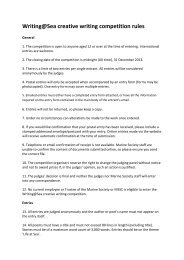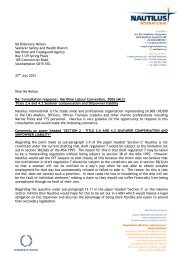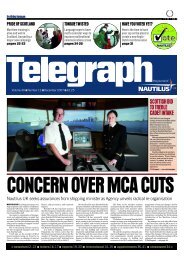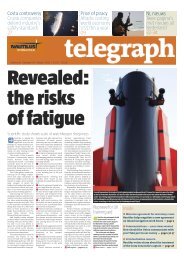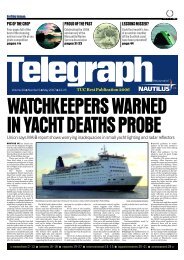NAUTILUS P01 OCTOBER 2010.qxd - Nautilus International
NAUTILUS P01 OCTOBER 2010.qxd - Nautilus International
NAUTILUS P01 OCTOBER 2010.qxd - Nautilus International
You also want an ePaper? Increase the reach of your titles
YUMPU automatically turns print PDFs into web optimized ePapers that Google loves.
October 2010 | nautilusint.org | telegraph | 31<br />
MARITIME HISTORY<br />
their ways and his first glimpse of<br />
the four-masted barque Wanderer<br />
became branded on his memory.<br />
Amidst the general turmoil of<br />
settling in, to his joy and amazement<br />
Masefield was invited to<br />
‘spin some ghost yarns’. He also<br />
discovered a talent for making<br />
sketches and drawings of<br />
ships which he kept in dedicated<br />
albums. It was to become a lifelong<br />
hobby.<br />
The second year on Conway<br />
was a happy time. Masefield had<br />
adapted to the ways of shipboard<br />
life. In class, under a sympathetic<br />
master, he was able to concentrate<br />
on history and English — subjects<br />
which really interested him.<br />
Devoted to reading books from<br />
the ship’s library, they were to<br />
imbue him with a deeply romantic<br />
attitude towards the sea and<br />
ships.<br />
In his final summer as a cadet<br />
he won an essay prize — a magnificent<br />
telescope. Still not yet 16,<br />
Masefield left Conway in 1894. He<br />
had been a senior petty officer for<br />
a term, and recognised as a youth<br />
who could take responsibility — a<br />
definite leader in his age group.<br />
Yet he was younger than most<br />
who were taken on as apprentices<br />
by the sailing ship companies.<br />
F<br />
Masefield’s first ship<br />
was the Gilcruix, a fourmasted<br />
barque belonging<br />
to White Star Line. He joined<br />
her in Cardiff, as she prepared for<br />
a voyage to Chile, which meant<br />
facing Cape Horn and being out<br />
of touch with land for several<br />
months. One of his duties was<br />
to keep a daily journal, which<br />
he did conscientiously until the<br />
ship reached Cape Horn. He later<br />
recalled climbing to the top of<br />
the masts: ‘I lay out on the yard,<br />
and the sail hit me in the face and<br />
knocked my cap away. It beat me<br />
and banged me, and blew from<br />
my hands. The wind pinned me<br />
flat against the yards; and seemed<br />
to be blowing all my clothes to<br />
shreds. I felt like a king, like an<br />
emperor.’<br />
He also recalled: ‘We got caught<br />
in the ice off the Horn and had our<br />
bows stove in, and had 32 days of<br />
such storm and cold I hope never<br />
to see again.’<br />
The Gilcruix eventually<br />
reached her destination of<br />
Iquique some 13 weeks after leaving<br />
Cardiff. At Iquique Masefield<br />
climbed alone into the steep<br />
hinterland behind the town: ‘It<br />
was a beautiful sight that anchorage<br />
with the ships lying there so<br />
lovely, all their troubles at an end.<br />
But I knew that aboard each ship<br />
there were young men going to<br />
the devil, and mature men wasted,<br />
and old men wrecked; and I wondered<br />
at the misery and sin which<br />
went to make each ship so perfect<br />
an image of beauty.’<br />
John Masefield became seriously<br />
ill in Chile — to the extent<br />
that he was classified as a Distressed<br />
British Seaman, which<br />
assured him a passage back to<br />
England by steamship. Convalescing<br />
during this leisurely voyage,<br />
he resolved not to finish his<br />
apprenticeship and abandon all<br />
ideas of pursuing a sea career.<br />
In hindsight he acknowledged:<br />
‘I shall always be glad of my short<br />
sea time. It was real, naked life...<br />
At sea you got manhood knocked<br />
bare, and it is a fine thing, a splendid<br />
thing.’<br />
F<br />
Masefield held to his<br />
earlier aspirations to be<br />
a writer, but his guardians<br />
scorned this determination.<br />
Arrangements were made for him<br />
to join another sailing ship, this<br />
time in America. Once there he<br />
felt free to obey his own impulses:<br />
‘I deserted my ship in New York,<br />
and cut myself adrift from her,<br />
and from my home. I was going to<br />
be a writer, come what might.’<br />
At the age of 17 John Masefield<br />
became a homeless vagrant,<br />
like innumerable others at this<br />
time of acute depression. It was<br />
to give him a lifelong sympathy<br />
with drifters, menials and the<br />
unemployed. Half-starved and<br />
unkempt, he later declared that<br />
he was also ‘marvellously happy’.<br />
Eventually finding work in a hotel,<br />
he then secured a job at a carpet<br />
mill. He was soon on friendly<br />
terms with his fellow workers<br />
in the cutting shop. Calling him<br />
‘Masey’, they good-humouredly<br />
teased him and mocked his English<br />
accent.<br />
One of his greatest joys in that<br />
two-year period was the time<br />
he had to read books. They were<br />
then so cheap he built up his own<br />
library. Acquiring a book by Chaucer,<br />
and knowing only that he was<br />
evidently considered the father<br />
of English poetry, Masefield was<br />
transfixed by what he read. In<br />
the language of Chaucer’s Middle<br />
English, he found validation of his<br />
own most treasured intuitions;<br />
that ‘life is very brief, and that the<br />
use of life is to discover the law of<br />
one’s being, and to follow that law,<br />
at whatever cost, to the utmost’.<br />
For Masefield, it was to be a poet.<br />
Practical realities tempered his<br />
ideals, but with sharpened resolve<br />
he returned to Britain, working his<br />
passage as a steerage steward on a<br />
steamer bound for Liverpool.<br />
F<br />
In his Conway days Liverpool’s<br />
Walker Art Gallery<br />
had been an enchanted<br />
place, mainly for its paintings<br />
of ships. Returning home with a<br />
maturity well beyond his years,<br />
Masefield had strong views on<br />
how sea life should be presented:<br />
‘It will be a good thing for England<br />
when painters and poets leave off<br />
painting and ranting about fishing<br />
smacks and pirates and “the<br />
dark blue sea”, and take to showing<br />
with their best ability the real<br />
life of the poor fellows who bring<br />
them not only their luxuries but<br />
their very food.’<br />
Over the next several years,<br />
whilst holding a job as a bank<br />
clerk in London, Masefield experimented<br />
with verse, children’s<br />
books, plays, naval histories, novels,<br />
and literary criticism. At the<br />
time of his 21st birthday, he had<br />
his first publishing success with a<br />
sea poem, now known as The Turn<br />
of the Tide.<br />
He also discovered the poetry<br />
of WB Yeats, describing the Irishman<br />
as ‘the only living poet whose<br />
heart has not got the moneygrubs<br />
and who writes from sheer<br />
joy much as a lark might sing’.<br />
Masefield and Yeats were to forge<br />
a close and lasting friendship,<br />
through which the sphere of new<br />
acquaintances admitted him into<br />
an intellectual circle that nurtured<br />
his talent and aspirations.<br />
F<br />
At the age of 23 he decided<br />
to sacrifice the security<br />
of a regular job and to<br />
embark on the uncertain life of a<br />
freelance writer. To his eventual<br />
successes in publications such as<br />
Tatler and Pall Mall Magazine he<br />
enthused: ‘My ballads are being<br />
taken as fast as I can write them.’<br />
I must go down to the seas again,<br />
to the lonely sea and the sky,<br />
And all I ask is a tall ship<br />
and a star to steer her by,<br />
And the wheel’s kick and the wind’s<br />
song and the white sail’s shaking,<br />
And a grey mist on the sea’s face,<br />
and a grey dawn breaking.<br />
from Sea Fever by John Masefield<br />
He was becoming known to a<br />
widening circle. Of his first published<br />
book of verse he level-headedly<br />
remarked: ‘Genius I’m not,<br />
but I’m pretty sure that I’ve kept<br />
my talents unrusted under pretty<br />
tough circumstances... I think the<br />
book deserves the recognition of a<br />
maritime people. It is something<br />
new said newly.’ Entitled Salt-<br />
Water Ballads, it attracted immediate<br />
attention, and included Sea-<br />
Fever, later to become his most<br />
widely-known poem.<br />
Masefield married Constance<br />
Crommelin, who was 11 years his<br />
senior. A gifted teacher, she took<br />
a sincere and enabling interest in<br />
his writing. Intensifying his freelance<br />
journalism, his book reviews<br />
were praised as ‘the shortest and<br />
most incisive we had. He could<br />
pack an extraordinary amount of<br />
criticism into a small paragraph’<br />
and as a playwright he received<br />
the annoying compliment of having<br />
his work plagiarised.<br />
By 1913, Masefield’s contribution<br />
to English literature meant<br />
that he had become a public figure.<br />
Shortly before the outbreak<br />
of the First World War his verse<br />
play Philip the King unusually<br />
depicted the defeat of the Armada<br />
as if seen through Spanish eyes.<br />
Such perspective proved a precursor<br />
to his unique interpretation<br />
of the Dardanelles campaign, and<br />
later of Dunkirk. His poem August<br />
1914 caught the anguish of the<br />
reality of war and set a sombre<br />
stage for the varied roles he was<br />
to play during forthcoming years,<br />
in England, France, the Mediterranean,<br />
and America.<br />
F<br />
Too old for the army,<br />
Masefield worked as an<br />
orderly for the British<br />
Red Cross at a hospital in France<br />
and was invited by the organisation<br />
to lead an expedition to the<br />
Dardanelles. An appeal for reinforcements<br />
had been made<br />
by the motor boat ambulance<br />
service, which carried wounded<br />
from the battle areas to a distant<br />
hospital on the island of Lemnos.<br />
Masefield secured funds,<br />
purchased launches and a barge<br />
and made passage from England.<br />
They arrived only to witness the<br />
final annihilation of Allied hopes<br />
on the Gallipoli peninsula.<br />
In early 1916 Masefield visited<br />
America on a lecture tour which<br />
was also an intelligence mission.<br />
In the German-dominated areas<br />
of the Mid-West, he was persistently<br />
questioned about the failure<br />
of the Dardanelles campaign.<br />
To counter such calculated negativity<br />
Masefield wrote his book<br />
Gallipoli, and its success led to<br />
him being invited by the British<br />
Commander-in-Chief, Sir Douglas<br />
Haig, to observe and chronicle<br />
the unfolding of the Battle of the<br />
Somme.<br />
Masefield came to believe that<br />
the Somme battle was the ‘biggest<br />
thing’ that England had ever<br />
been engaged in, that it must be<br />
a ‘possession of the English mind<br />
for ever’. He was thus aware of the<br />
John Masefield at home with his sister, Norah, and the telescope he won as<br />
an essay prize whilst training as a cadet onboard HMS Conway<br />
privilege of being its chronicler.<br />
Yet because of bureaucracy and<br />
politics he was hamstrung in his<br />
endeavour, to the probable detriment<br />
of recorded history.<br />
In 1918 Masefield was summoned<br />
for a second American lecture<br />
tour. He spoke impromptu,<br />
with great success, to vast audiences<br />
of enlisted men who would<br />
soon be fighting in Europe.<br />
F<br />
Always a countryman<br />
at heart, Masefield settled<br />
back into rural<br />
surroundings after the war. Like<br />
John Masefield was recognised as a potential leader during his time onboard the school ship HMS Conway<br />
so many others, he and his wife<br />
shared the urge to create a ‘better<br />
England’. Active once more in<br />
the promotion and recognition of<br />
poetry in Britain, famed on both<br />
sides of the Atlantic for his affinity<br />
with the common man, he was<br />
appointed Poet Laureate by King<br />
George V.<br />
For the rest of his life he brought<br />
dedication and dignity to that<br />
office. He was to write with boyish<br />
enthusiasm on the launching of<br />
what became the great Cunarder<br />
Queen Mary: ‘…Parting the seas<br />
in sunder in a surge/Treading a<br />
trackway like a mile of snow…’<br />
In the second world war, Masefield’s<br />
son Lewis — a conscientious<br />
objector — enlisted in the<br />
Royal Army Medical Corps and<br />
was killed by artillery fire in the<br />
African desert.<br />
John Masefield produced a<br />
book about the evacuation of<br />
Dunkirk, but for security reasons<br />
it was not published in full until<br />
1973, as The Twenty Five Days.<br />
Masefield’s wife died in 1960,<br />
after which he became increasingly<br />
solitary. He remained an<br />
elder beloved for his courtesy and<br />
kindness, who faced up to the burdens<br />
of being in the public limelight,<br />
and to the end was ‘a devotee<br />
of beauty in all its forms, and a<br />
searcher for ultimate truths’.<br />
He passed away in 1967; his<br />
remains lie in Poets’ Corner at<br />
Westminster Abbey.<br />
Of his two most celebrated<br />
poems — Sea-Fever, and Cargoes<br />
— written at the start of his<br />
literary career, no less an authority<br />
than John Betjeman has suggested<br />
that they would be ‘remembered<br />
as long as the language lasts’…<br />
i The author kindly<br />
acknowledges the material<br />
assistance of Constance<br />
Babington Smith and Philip<br />
Errington.



